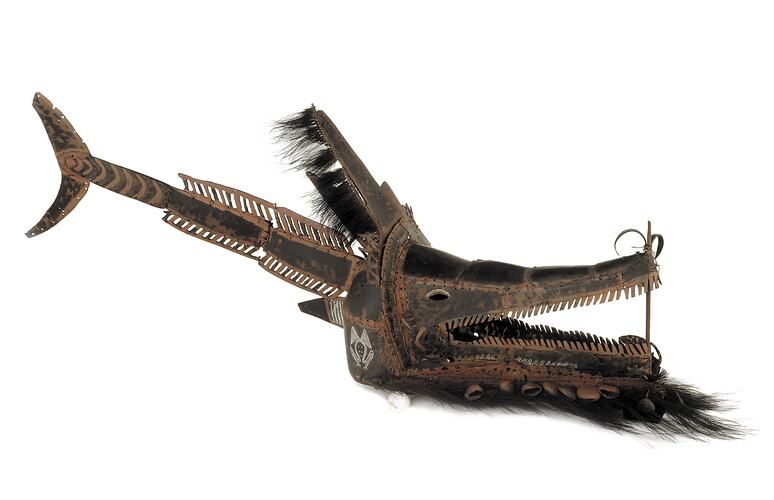Physical Description
A headdress in the form of a crocodile with a fish tail. It is made mainly from tortoise shell and the shell of the hawksbill turtle. Cassowary feathers, shells and seeds are attached to the lower jaw and cassowary feathers are also attached at the top. It is painted with natural pigments.
Significance
The nineteenth century headdress is a fine example of the very long and important cultural tradition of mask making in the Torres Strait. It is of international significance and predates those collected by Alfred Cort Haddon during the famous Cambridge Anthropological Expedition to the Torres Straits in 1898. The relatively limited holdings of Torres Strait Islander nineteenth century cultural objects are to be found in the collections of the Australian Museum, Queensland Museum and Museum Victoria. This mask was amongst a collection of 514 'New Guinea curios' from the Fly River region in New Guinea received in 1885 by the National Gallery of Victoria from a larger collection made as part of the Royal Geographical Society of Australasia's (RGSA) expedition to New Guinea in 1885. Most of the objects now held by Museum Victoria were collected on the 2nd and 3rd of August that year as part of the second RGSA expedition to the Fly River led Captain H. C. Everill. His strategy after failing to collect much in the region was to leave 'some presents of cloth, tomahawks, tobacco, beads, &c.' and in return he selected 'some articles from their canoes, which were very full of their household goods'. A trade network existed between the Torres Strait and the Fly River regions, and some masks and distinctive warup drums were in fact made in the Kiwai region and traded south to the islands of the Torres Strait. Once the expedition returned to Sydney, the Geographical Society of Australasia displayed the collection of 'curios' to 'show the public that the expedition' had 'done really good work'. After the initial exhibition in Sydney, the collection was shared between the various contributing colonies with Baron von Mueller receiving approximately 1,000 botanical specimens and the National Gallery of Victoria receiving their share of the curio collection.
More Information
-
Object/Medium
Headdress
-
Maker
-
Locality
-
Date Produced
-
Date Collected
-
Object Measurements
1460 mm (Length), 470 mm (Width), 630 mm (Height)
-
Keywords
-
References
[Catalogue] 2000. Bunjilaka: The Aboriginal Centre at Melbourne Museum.
[Catalogue] Mosby, Tom & Robinson, Brian. Ilan Pasin: this is our way. Torres Strait Art.
-
Type of item
-
Discipline
-
Category
-
Collecting Areas
Australian Indigenous - Northern Australia and Queensland and Torres Strait Islands
